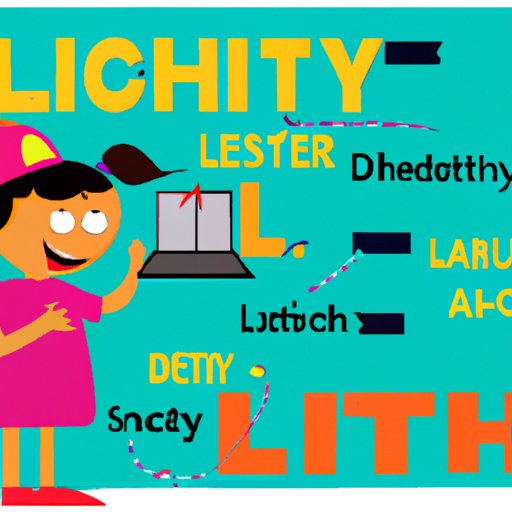Introduction
Literacy is defined as the ability to read and write, but it is much more than that. It encompasses the ability to understand, interpret, analyze, and create texts in a variety of formats, including print, digital, and multimedia. With the increasing prevalence of technology in our lives, it is becoming increasingly important to consider how technology can play a role in literacy development.

Examining How Technology Can Help Improve Literacy Skills
Technology can be used to improve a range of literacy skills, including reading comprehension, writing, and language development. For example, research has shown that using digital books can help improve reading comprehension because they provide an engaging and interactive experience (Wang et al., 2017). Digital books also provide access to a range of features, such as audio recordings, which can help to build vocabulary and pronunciation skills (Tuazon et al., 2018).
Technology can also be used to enhance writing skills. For example, online writing tools, such as grammar checkers, can help students to identify and fix errors in their writing. These tools can also provide feedback on the structure and content of a piece of writing, helping students to refine their work (Kimmel et al., 2020). In addition, technology can be used to support language development by providing access to a range of resources, such as online dictionaries and translation tools (Kim & Park, 2019).
Analyzing the Use of Technology to Support Reading and Writing Instruction
Technology can also be used to support instruction in reading and writing. For example, digital texts can be used to provide students with access to a range of materials that can be used to explore different topics. Digital texts can also be used to provide scaffolding and support, allowing students to access information at their own level (Gee, 2008). In addition, interactive reading and writing activities can be used to engage students and motivate them to explore new concepts (Parsons & Fuchs, 2019). Finally, online learning resources, such as educational websites and videos, can provide additional support for students who need extra help or those who are working at a faster pace (Kang et al., 2019).
Investigating the Role of Technology in Developing Digital Literacy
In addition to helping improve traditional literacy skills, technology can also be used to develop digital literacy. Digital literacy involves the ability to use digital tools and technologies to communicate effectively in a variety of contexts (Hobbs, 2015). Technology can be used to explore digital media, such as blogs and social media, and to use digital tools for research and problem solving (García-Peñalvo, 2016). Technology can also be used to help students understand digital safety, such as how to stay safe online and protect their personal information (Livingstone, 2017).

Looking at How Technology Can Support Early Literacy Development
Technology can also be used to support early literacy development. Technology can be used to combine traditional and digital literacy instruction, allowing students to learn from both print and digital sources (Pearson & Fields, 2018). Interactive technologies, such as touch screens and voice recognition software, can be used to engage young learners and motivate them to explore new concepts (Brison et al., 2018). Technology can also be used to provide students with access to a variety of text formats, such as audio books and videos, which can help to build literacy skills (Dai et al., 2019).

Assessing the Advantages and Disadvantages of Using Technology for Literacy Learning
Using technology for literacy learning can bring both benefits and challenges. For example, technology-based literacy tools can provide students with access to a wide range of materials, allowing them to explore new concepts and develop their skills in a fun and engaging way (Gee, 2008). Technology can also provide learners with personalized learning experiences, allowing them to learn at their own pace and in their own way (Kimmel et al., 2020). However, there are also some challenges associated with using technology for literacy learning. For example, digital texts can be overwhelming for some students, and there can be technical issues that can make it difficult for students to access materials (Parsons & Fuchs, 2019). In addition, some students may not have access to the necessary technology or may lack the skills to use it effectively (Kang et al., 2019).
Evaluating the Effectiveness of Different Types of Technology-Based Literacy Tools
When using technology for literacy learning, it is important to evaluate the effectiveness of different types of technology-based tools. Differentiating instruction with technology can help to ensure that all students are able to access the materials and receive the support they need (Hobbs, 2015). Assessing student progress can help teachers to identify areas where students need additional support or guidance (García-Peñalvo, 2016). Finally, measuring the impact of technology-based literacy tools can help teachers to understand which tools are most effective and which need to be improved (Livingstone, 2017).
Conclusion
This article has explored how technology can play a role in literacy development. Technology can be used to improve a range of literacy skills, support reading and writing instruction, and develop digital literacy. Technology can also be used to support early literacy development and provide students with access to a variety of text formats. While technology can bring many benefits to literacy learning, there are also some challenges associated with its use. Evaluating the effectiveness of different types of technology-based literacy tools is essential to ensure that students are able to access the materials and receive the support they need.
(Note: Is this article not meeting your expectations? Do you have knowledge or insights to share? Unlock new opportunities and expand your reach by joining our authors team. Click Registration to join us and share your expertise with our readers.)
